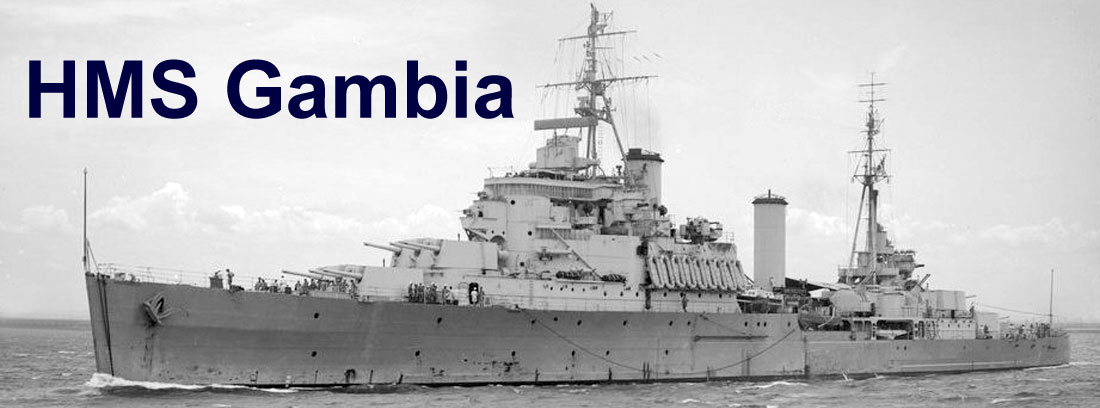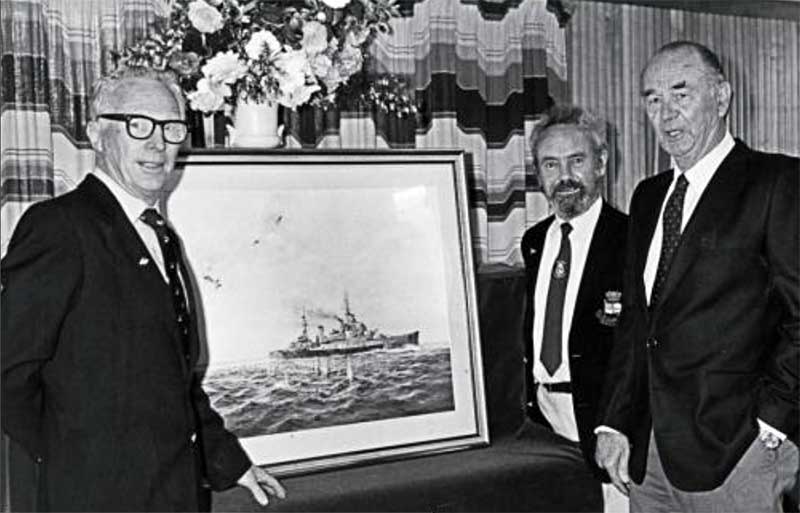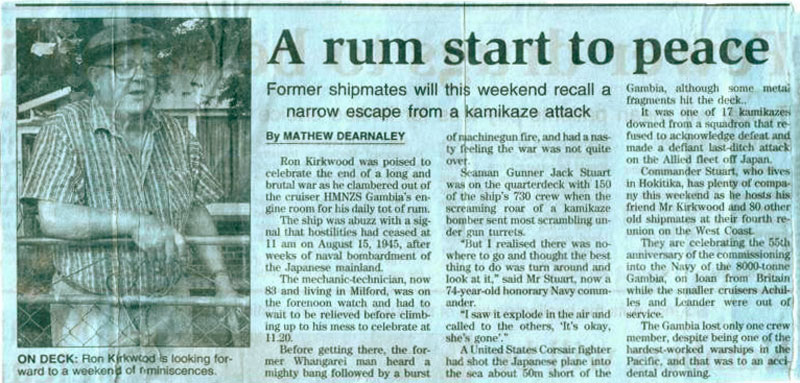
Jack Stuart
Jack was one of the crewmen who were part of the RN/RM landing force from the ship that took the surrender of Yokosuka Naval Base on August 20, 1945. The platoon of Royal Marines were led by Captain Blake, RM and two platoons of seamen from Gambia with company headquarters under the command of Lieutenant-Commander G.R. Davis-Goff DSC, RNZN took the surrender of the Japanese Naval Base at Yokosuka. The men of the force included Watty Bird, James Murray and Jack Stuart.
From Top Gun Crewmen Visit WWII Pilot Who Saved Their Ship - Sun-Sentinel - October 25, 1990
Top Gun Crewmen Visit WWII Pilot Who Saved Their Ship
By Steven R. Biller, Sun-Sentinel, October 25, 1990
Walk into Marshall Lloyd`s waterfront Delray Beach home, and he will take you first to his favorite painting. It is a colorful representation of an endlessly celebrated day -- the last day of World War II -- when a U.S. Navy Corsair pilot saved the New Zealand cruiser Gambia from a kamikaze air attack.
Two Gambia crewmen, Jack Stuart and Colin Howat, saw the painting again last weekend when they arrived from Hokitika, New Zealand, for a second reunion with Lloyd, the pilot who saved their ship. The two sailors still talk about the painting and the day their ship was saved
It was the morning of Aug. 15, 1945. A "cease hostilities against Japan" order came at 11:23 a.m., to signal the end of World War II. Lt. Cmdr. Stuart and Howat stood on the Gambia`s top deck with 188 others, all proudly waving their white caps in celebration. Suddenly, a kamikaze plane came darting violently toward the Gambia. Stuart yelled for his shipmates to scatter, but there was no place the crew could run.
An American pilot appeared from the clouds and sent the kamikaze plane flaming into the water. "No Japanese were supposed to be flying there," Lloyd`s wife, Virginia, said. "No one will ever know if that Japanese pilot knew the war was over." The kamikaze pilot was aiming for the British Carrier Indefatigable. But the U.S. pilots shot and disabled the plane, sending it straight for the Gambia. The Japanese plane was shot down so close to the Gambia that many of the crewmen salvaged parts of the plane`s wreckage from the deck of the cruiser and kept them as souvenirs, Virginia Lloyd said.
Stuart was determined to meet his rescuer. His search lasted 25 years, because the New Zealand crew thought a British Seafire saved their cruiser. "I wrote to a British historian, but it turns out that there was no Seafire flying that day," Stuart said. A log that listed "kills" made for Aug. 15 showed that the plane was an American Corsair.
A Navy officer in Washington helped solve the mystery. In 1986, a list of names led Stuart to Lloyd. "I got right on the phone," Stuart said. "I was never so excited. But I didn`t realize when I called that it was 3 a.m. in the United States."
Nearly two years later, the Lloyds and the Gambia crew would reunite in New Zealand. Expecting a reminiscent, easygoing 30-day visit to Hokitika, a small town of about 3,500, Lloyd arrived a hero at a bombastic celebration. There was a parade. Children were dressed in sailor`s outfits. Shopkeepers placed welcome signs in their windows. "Everybody wanted to talk to us," Lloyd said. "I remember the day like it was yesterday. All the kids were dressed up and they all very hospitable."
Said Virginia: "One of the most touching memories about the 1988 reunion in New Zealand was speaking to the wives of the men who were on the Gambia. They kept coming up to Marshall to touch him on the arm to thank him, because without Marshall, they wouldn`t have had their husbands or their children any more."
A Gambia replica was built on a storefront to commemorate Lloyd`s camaraderie. "It was the biggest event that happened in our little town," Stuart said. More than 250 Gambia crew members and their families who attended the reunion insisted that a 50th anniversary reunion be held in New Zealand in 1995.
Meanwhile, Stuart and Howat made their way to the United States, and the Lloyds have their guests` vacation planned. Sightseeing trips will include Cape Canaveral, Epcot Center and Key West. They will see the Philharmonic Orchestra of Florida and cruise the Intracoastal Waterway on the Lloyds` 30- foot boat. Although Stuart and Howat are startled by Florida`s attractions, they treasure equally brief moments in the Lloyds` den where there is an array of wartime memorabilia. They were speechless while staring at a photograph of the 1988 reunion.

From West Coast Messenger, August 16, 2017. Photo: Clarrie Reid
Jack Stuart, left, Colin Howat and visitor posing with a portrait of HMNZS Gambia in action. Jack and Colin both saw action on the Gambia and organized the 40th reunion in 1983 in Hokitika.
You may recognize the framed print they are holding. It was used as the cover of HMNZS Gambia by Jack S. Harker. Moana Press, New Zealand, 1989.
This newspaper clipping was on the original HMS Gambia Association website but there were no other details about it. HMS Gambia was commissioned into the the Royal New Zealand Navy in May 1944, as these men were celebrating the 55th anniversry of that, I think this article was published in 1999.

A Rum Start to Peace
A Rum Start to Peace
By Mathew Dearnaley
Former shipmates will this weekend recall a narrow escape from a kamikaze attack
On Deck: Ron Kirkwood is looking forward to a weekend of reminiscences.
Ron Kirkwood was poised to celebrate the end of a long brutal was as he clambered out of the HMNZS Gambia's engine room for his daily tot of rum.
The ship was abuzz with a signal that hostilities had ceased at 11am on August 15, 1945, after weeks of naval bombardment of the Japanese mainland. The mechanic-technician, now 83 and living in Milford, was on the forenoon watch and had to wait to be relieved before climbing up to his mess to celebrate at 11:20.
Before getting there, the former Whangarei man heard a mighty bang followed by a burst of machinegun fire, and had a nasty feeling the war was not quite over.
Seaman gunner Jack Stuart was on the quarterdeck with 150 of the ship's 730 crew when the screaming roar of a kamikaze bomber sent most of scrambling under gun turrets. "But I realized there was nowhere to go and thought the best thing to do was turn around and look at it," said Mr. Stuart, now a 74-year-old honourary Navy Commander. "I saw it explode in the air and called to the others, 'It's okay, she's gone'."
A United States Corsair fighter had shot the Japanese plane into the sea about 50m short of the Gambia, although some metal fragments hit the deck. It was one of 17 kamikazes downed from a squadron that refused to acknowledge defeat and made a last-ditch attack on the Allied fleet off Japan.
Commander Stuart, who lives in Holkitika, has plenty of company this weekend as he hosts his friend Mr. Kirkwood and 80 other old shipmates at their fourth reunion on the West Coast. They are celebrating the 55th anniversary of the commissioning into the Navy of the 8,000-tonne Gambia, on loan from Britain while the smaller cruises Achilles and Leander were out of service.
The Gambia lost only one crew member, despite being one of the hardest-worked warships in the Pacific, and that was to an accidental drowning.